Barcelona: A Combative May Day Regained
. | 05.05.2011 15:35 | Social Struggles | Workers' Movements
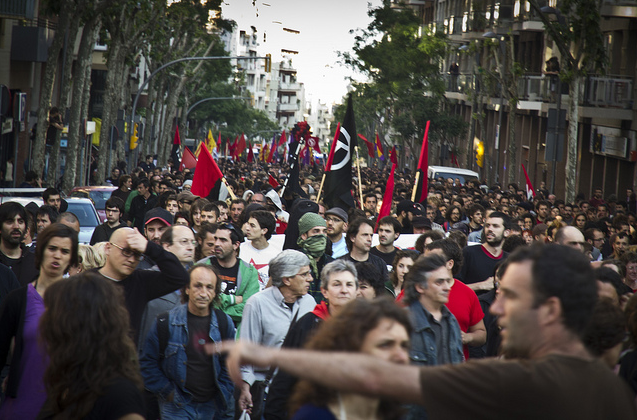
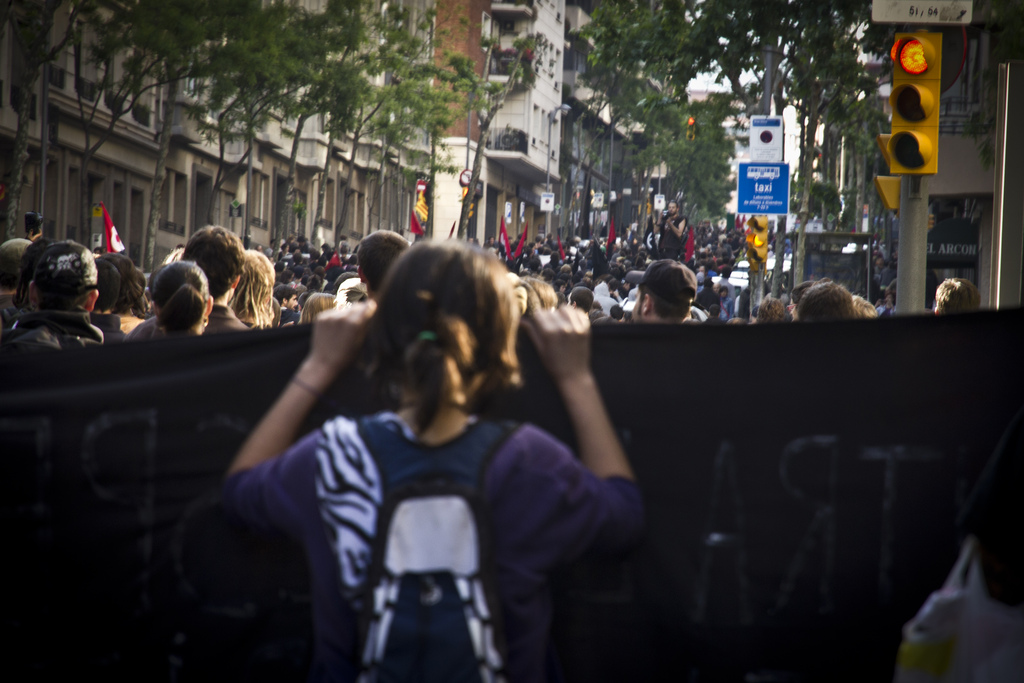
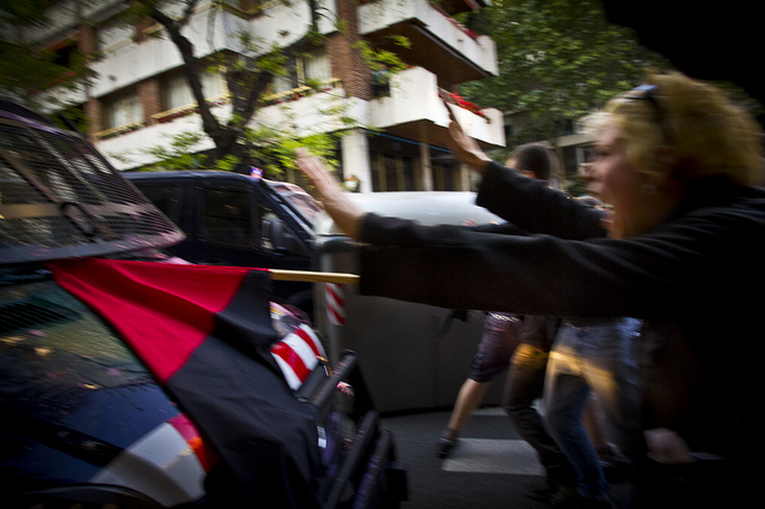
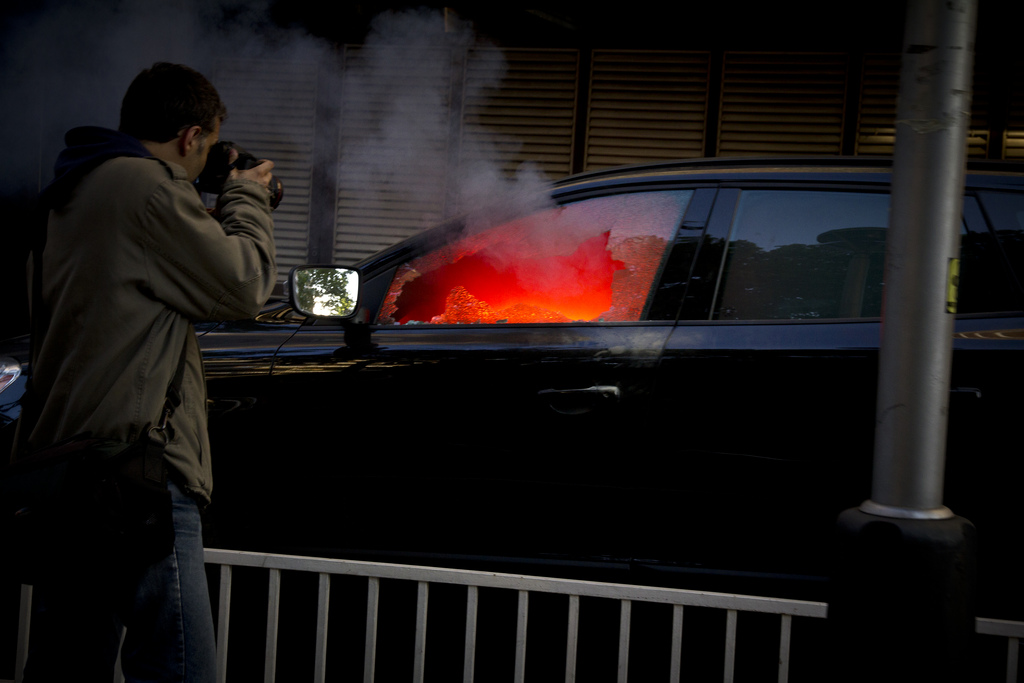

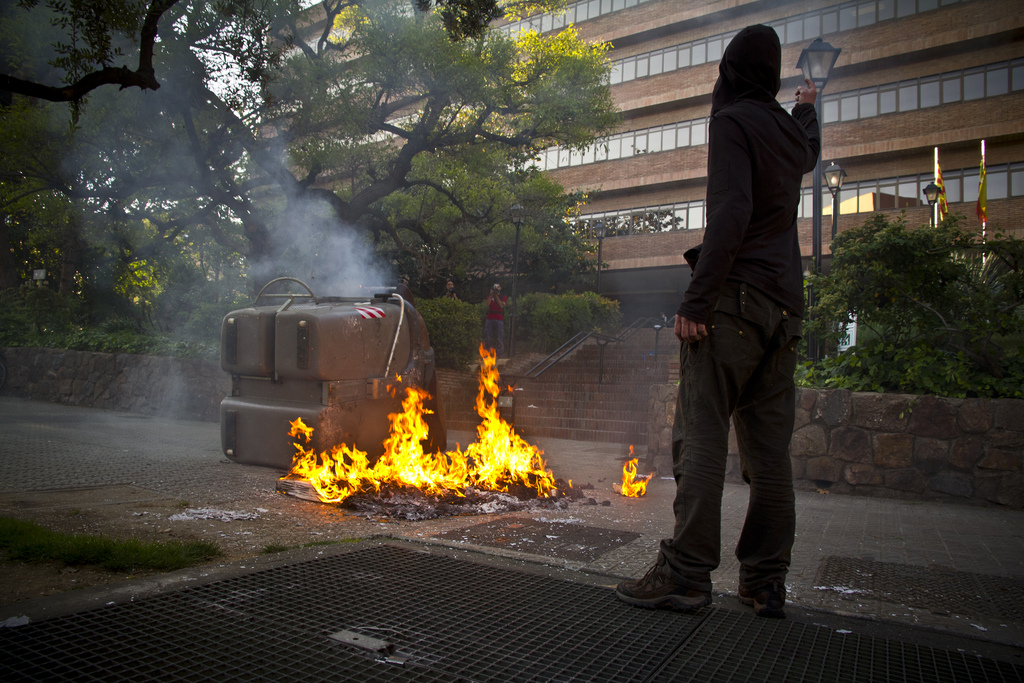
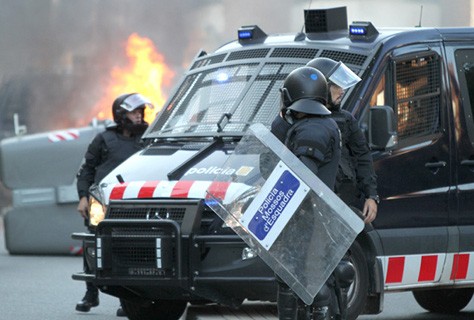
May Day 2011 comes on the heels of two general strikes (29S, in September, called for by all the unions, and 27G, in January, called only by the anarchosyndicalist and radical indepe unions). These strikes saw the creation of over half a dozen neighborhood assemblies and a periodic coordination between them, as well as other groups organizing at a citywide level. The confrontational barricades and pickets of the minoritarian unions (CNT and CGT) were vindicated, as were the insurrectionary anarchists' tactics of attack and idea of an uncontrolled generalization of the struggle.
The CNT in particular regained credibility, as the role of the official unions in approving the Labor Reform became undeniable (the CNT, or rather the various CNT splinter groups, are the only labor union that rejected the Moncloa Pact that turned unions into the political parties of the workplace).
An activist branch of this multicephalous, undefinable movement won a great deal of credibility by occupying a state bank building in the center of the city just before the September strike, playing a key role in the events to unfold, and signaling the presence of a political current reminiscent of the antiglobalization movement. In this chronicler's opinion, they lost most of their credibility in the second strike by attempting to repeat the exact same occupation action in a different location and being quickly squashed by the police, against whom they discouraged any physical resistance. Subsequently, this current did not make themselves felt on May Day, although they do continue to have a strong presence in the neighborhood assemblies.
In the streets, anarchists mixed with radical Catalan independentistas (who, dubious politics aside, proved themselves in battles with the cops) and a whole mix of people generally not involved in either politics or social struggles. In the bigger September strike as much as in the smaller January non-strike, comrades took the initiative, energized themselves, and learned what works and what doesn't on a citywide scale.
The black bloc, or those operating within a framework of conflictivity, thrived in this environment. Because they had never adopted a politics of waiting for the right moment, but rather developed their attack against the State come rain or shine, they could draw on a much deeper reserve of experience and confidence, making themselves indispensable to the syndicalists and independentistas who had newly found a need to be disruptive. Thus, they could continue to be critical of their political peers without burning bridges or destroying the possibility of joint action in pluralistic spaces of social struggle. They only won recourse to this wider and more chaotic field of action by putting solidarity above disdain, a marked change from the days of squatter isolationism.
In the month leading up to May Day, all these different currents carried out actions at an increasing pace. The neighborhood assemblies mobilized to resist mortgage evictions, held talks or handed out flyers in the streets. The CNT protested and picketed against the firing and harrassment of workers. Medical employees raised hell about the massive slashes to the health sector. Anonymous criminals smashed banks, or spraypainted them in broad daylight, and there were also a series of actions in solidarity with the Chilean anarchists in prison.
In the last weeks of April, a black poster appeared on the walls across the city bearing the title: “1 May: Day of Struggle, Day of Vengeance” and a text about the history of May Day. Around the same time another poster came out bearing the faces of three of the last urban guerrillas executed by the Franco regime, pointing out that these popular heroes weren't martyrs and victims, but combatants, and they didn't die for democracy, but for the struggle against capitalism, and that struggle is still ongoing.
During the last days of the countdown, the two different CNT factions added their own posters announcing the protest, one under the title "let's regain the spirit of struggle," and what they lacked in content, they made up for in quantity, with few city blocks going undecorated.
In the early morning hours of Thursday, 28 April, arterial roads leading into Barcelona were blocked at two different points by barricades of burning tires, the work of people the police dubiously designated as “squatters”. A few hours later the Chilean consulate was occupied in solidarity with the comrades on hungerstrike.
The day before, a protest had been called for that evening after the suicide of Patricia Heras, one of the prisoners of the police frame-up of 4F. Not even present at the scene of a riot in 2006 at which a cop was severely injured, Patricia Heras received a three year prison sentence after an excruciatingly long trial process. She had finished several months of her sentence and was currently in the “third degree” (weekdays out, nights locked up). On the night of Tuesday, April 26, rather than go back to prison, she went home and killed herself. On Thursday afternoon, hundreds of people gathered in El Forat in a torrential downpour and took to the streets, marching to Wad Ras, the women's prison, filling the air with chants against the police and the prisons, and the walls with graffiti of the same ilk. At the prison they lit off firecrackers and traded shouts of love with those on the other side of the wall.
Communique translated from Barcelona Indymedia
Response to the Death of Patricia Heras in Barcelona
The night of Thursday, 28 April, we attacked two banks on Rogent street with hammers. We did it to respond to the death of a comrade; to allow our rage to erupt rather than anaesthetizing it; so that those who profit off our misery also reap the consequences. We would like to be able to avenge Patricia attacking the cops, judges, and journalists responsable for the 4F frame-up, but at the moment, our desires aside, we'll stick with attacking two offices of their owners.
Patrici, we won't forget you. You are with us. We'll continue fighting against patriarchy, against the prisons and against all domination until everyone is free.
(Subsequently, on the night of 2 May, the city hall of Girona, another city in Catalunya, was attacked with rocks and spraypainted with the phrase, "We don't forget Patri, PSC [Socialist Party, in government at the time of the 4F frameup] murderers")
The night of April 30, the International Day of Sabotage, Witches' Night, attacks against temp agencies, banks, and labor institutions were carried out all across the city.
Communique translated from Barcelona Indymedia, from one action of many
Temp Agency Attacked on Marina Street
Is it even necessary to justify attacking a business of exploitation and precarity? In fact, not attacking it would be a grave lack of respect for ourselves and for the tradition of struggle on 1 May. For that reason, we decided to join rebels all over the world who still remember that the night of 30 April is a night dedicated to sabotage. Death to the State and Long Live Anarchy.
--Banda Subversiva de Piedras Voladoras
In the morning of Sunday, 1 May, the CNT(s) and CGT, not to mention some indepe groups and the official unions, had their various public events. The CNT, it is worth noting, marched down Les Rambles, a street usually off-limits to protests, shocked the tourists, spraypainted, and casually sabotaged a little construction site in Raval, breaking the tools and telling the workers to join the strike.
The big protest was to gather at five in the afternoon at Jardinets de Gracia. Rather than marching through the tourist-infested center, as most marches do, this one was planning to head to Sarrià, the quintessential rich neighborhood up on the hill. At five-thirty, a crowd of 4-6,000 set off up Diagonal Avenue, with flags and banners marking different contingents of anarchosyndicalists, black bloc, and non-party indepes. At the first intersection where a large group of riot police could be seen, the march stopped and people shouted at them lividly. The name “Patricia Heras” rang through the air. A shortwhile later, the President of Catalunya and another high functionary were burned in effigy. The first government office on the route was bathed in paint. It seems that this time, people skipped the lightbulbs or eggshells and just went with mason jars.
The sound of breaking glass from the paintbombs was contagious, and soon more and more people in the crowd were masked up, small groups making sorties to the side of the march to leave graffiti. As the crowd turned up Via Augusta into the rich zone, people decided the time for vengeance was at hand. First, every bank, chain store, or dumpster the march passed was spraypainted with anarchist slogans. Before long, a small crew broke out of the march and attacked a bank with hammers. Except for a few Stalinists, everyone in the crowd cheered, from students to grandparents. The attacks multiplied, as people flipped dumpsters and set them alight. The more prepared attacked right and left with hammers, the more spontaneous liberated stones and bottles from the stultifying urban architecture. Within an hour, easily a hundred targets—banks, government buildings, chain stores, beauty salons, car dealerships, luxury car showrooms, privately owned luxury cars—were vandalized, with several smashed to hell and damaged on the inside too.
Twice, a large group of undercovers attempting to approach were chased off with rocks and bottles. After the destruction started in earnest, the riot vans drove up on the back of the march, but they were held off by the rear banner—valiently carried first by indepes then by CNT activists—and dissuaded by dumpsters, paintbombs, and bottles. Strategically, the police were disinclined to attack the march because charging a multigenerational labor union march that included a broad political spectrum would come with a serious backlash in a country that remembers its history and is apt to associate the police with dictatorship. Neither were they keen on fragmenting a single march into a hundred violent fractions in the middle of a wealthy neighborhood whose streets are not wide and grid-like but narrow and windy.
But finally, at about 7:30 around the altitute of Ganduxer, the destruction had reached such proportions that the police charged. Hundreds of riot cops and undercovers broke through the rear banner and crushed any resistance, sparking a general panic and causing the back of the march to split into three groups, some of which blockaded their exit streets with barricades and automobiles. They arrested six and beat many. The media claimed they used a new crowd control weapon consisting of a shotgun that sends out a precision, paralyzing shot that can take down specific troublemakers; however this appears to be misinformation that was included in a press release written before the protest ever happened. Those arrested report being pacified with truncheons, telescoping batons, or in one case, a teargas grenade launcher used as a bludgeon. Another rumour circulated that the police had hoped to use their new weapon during the protest, but would instead inaugurate it during any disorders after the Barcelona-Madrid football match a couple days later.
The different segments of the march quickly regrouped, leaving hundreds of items of black clothing strewn on the ground behind them, left Sarrià and returned to Diagonal, arriving at the end point, a building of symbolic importance in the struggle of the health sector workers, where a statement was read and the march was unconvened. Several individuals were arrested by undercovers while leaving. It is assumed that those who filed their names to request the legalization of the march (organized by a joint group including the radical unions and some indepe groups) will receive heavy fines, which will be paid by the organizations behind them.
That night graffiti went up on the walls celebrating the acts of revenge taken against the rich.
Fifteen people were arrested in total. The following day, a concentration was held outside the police station, and two hundred people blocked the street. The following day, 3 May, a continuous crowd gathered outside the courts to welcome the detainees upon their release. Four people were charged with the equivalent of misdemeanors, and eleven people with the equivalent of felonies—public disorder, and in some cases assaulting authorities and destruction of property. In the most serious case, the comrade faces a prosecutor's petition of three and a half years in prison, while in many other cases the petition is for two years' imprisonment. One of the arrested had both his arms broken, and many others were injured as well. Most were beaten during and after the arrest.
The common feeling is that the struggle will continue, and stronger than before. Even after the last prisoner was released, the rich neighborhood remained trashed. Passersby did double-takes to see a paving stone two feet across lodged comfortably in the front window of an Audi dealership as business tried unconvincingly to carry on as usual. The social war had come home.
 http://325.nostate.net/?p=2349
http://325.nostate.net/?p=2349
.
 Homepage:
http://325.nostate.net/?p=2349
Homepage:
http://325.nostate.net/?p=2349
Comments
Display the following 2 comments